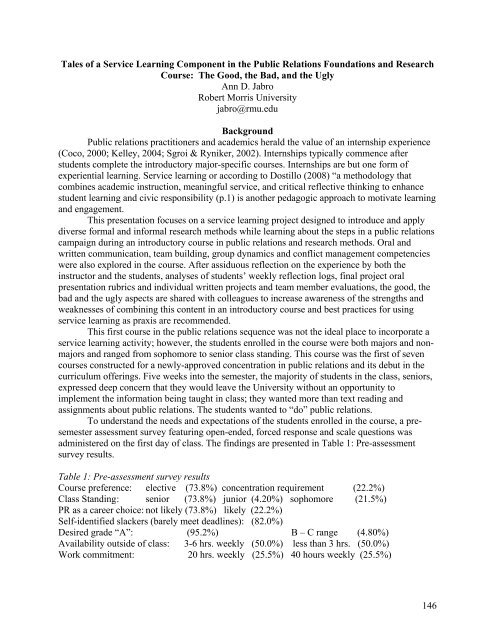2008 PROCEEDINGS - Public Relations Society of America
2008 PROCEEDINGS - Public Relations Society of America
2008 PROCEEDINGS - Public Relations Society of America
You also want an ePaper? Increase the reach of your titles
YUMPU automatically turns print PDFs into web optimized ePapers that Google loves.
Tales <strong>of</strong> a Service Learning Component in the <strong>Public</strong> <strong>Relations</strong> Foundations and Research<br />
Course: The Good, the Bad, and the Ugly<br />
Ann D. Jabro<br />
Robert Morris University<br />
jabro@rmu.edu<br />
Background<br />
<strong>Public</strong> relations practitioners and academics herald the value <strong>of</strong> an internship experience<br />
(Coco, 2000; Kelley, 2004; Sgroi & Ryniker, 2002). Internships typically commence after<br />
students complete the introductory major-specific courses. Internships are but one form <strong>of</strong><br />
experiential learning. Service learning or according to Dostillo (<strong>2008</strong>) “a methodology that<br />
combines academic instruction, meaningful service, and critical reflective thinking to enhance<br />
student learning and civic responsibility (p.1) is another pedagogic approach to motivate learning<br />
and engagement.<br />
This presentation focuses on a service learning project designed to introduce and apply<br />
diverse formal and informal research methods while learning about the steps in a public relations<br />
campaign during an introductory course in public relations and research methods. Oral and<br />
written communication, team building, group dynamics and conflict management competencies<br />
were also explored in the course. After assiduous reflection on the experience by both the<br />
instructor and the students, analyses <strong>of</strong> students’ weekly reflection logs, final project oral<br />
presentation rubrics and individual written projects and team member evaluations, the good, the<br />
bad and the ugly aspects are shared with colleagues to increase awareness <strong>of</strong> the strengths and<br />
weaknesses <strong>of</strong> combining this content in an introductory course and best practices for using<br />
service learning as praxis are recommended.<br />
This first course in the public relations sequence was not the ideal place to incorporate a<br />
service learning activity; however, the students enrolled in the course were both majors and nonmajors<br />
and ranged from sophomore to senior class standing. This course was the first <strong>of</strong> seven<br />
courses constructed for a newly-approved concentration in public relations and its debut in the<br />
curriculum <strong>of</strong>ferings. Five weeks into the semester, the majority <strong>of</strong> students in the class, seniors,<br />
expressed deep concern that they would leave the University without an opportunity to<br />
implement the information being taught in class; they wanted more than text reading and<br />
assignments about public relations. The students wanted to “do” public relations.<br />
To understand the needs and expectations <strong>of</strong> the students enrolled in the course, a presemester<br />
assessment survey featuring open-ended, forced response and scale questions was<br />
administered on the first day <strong>of</strong> class. The findings are presented in Table 1: Pre-assessment<br />
survey results.<br />
Table 1: Pre-assessment survey results<br />
Course preference: elective (73.8%) concentration requirement (22.2%)<br />
Class Standing : senior (73.8%) junior (4.20%) sophomore (21.5%)<br />
PR as a career choice: not likely (73.8%) likely (22.2%)<br />
Self-identified slackers (barely meet deadlines): (82.0%)<br />
Desired grade “A”: (95.2%) B – C range (4.80%)<br />
Availability outside <strong>of</strong> class: 3-6 hrs. weekly (50.0%) less than 3 hrs. (50.0%)<br />
Work commitment: 20 hrs. weekly (25.5%) 40 hours weekly (25.5%)<br />
146
















